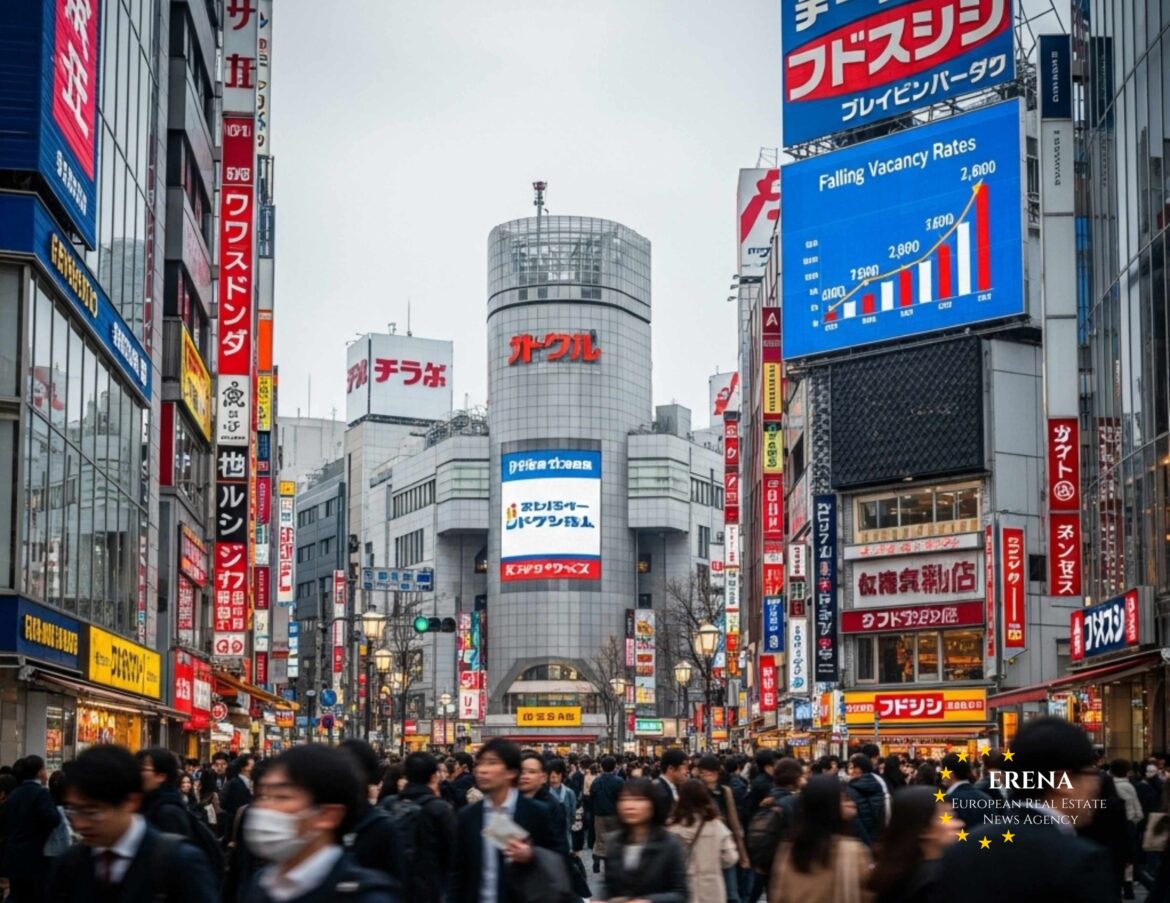The Tokyo office real estate market continues to show signs of recovery, with the vacancy rate declining for the third consecutive quarter. According to a report by Miki Shoji, the average vacancy rate in Tokyo’s central districts—including Marunouchi, Shinjuku, Ginza, and Shibuya—fell to 5.5% in Q1 2025, down from 5.9% in the previous quarter and 6.5% a year earlier.
This trend reflects not only growing business confidence but also structural shifts in tenant preferences as they adapt to the post-pandemic reality.
Declining Vacancies and Increased Leasing Activity
Analysts report a rise in leasing contracts in Tokyo’s key business hubs. Companies in finance, IT, and consulting are particularly active. According to CBRE Japan, the total volume of new leasing contracts in central Tokyo rose by 12% year-over-year.
Landlords, previously burdened with long vacancy periods, are now seeing increased demand for large office spaces ranging from 300 to 1,000 square meters. Businesses are increasingly looking to consolidate staff under one roof, especially under hybrid work models.
Drivers of Market Improvement
1. Return to Offices and Hybrid Work Models
Since 2024, more Japanese companies have resumed on-site work or adopted hybrid schedules. This has prompted a reevaluation of office layouts and growing demand for modern spaces with meeting rooms, wellness zones, and improved ventilation systems. Firms are seeking environments that support company culture and employee productivity.
2. Resilient Japanese Economy
Despite global economic challenges, Japan’s economy remains stable. GDP grew by 1.1% in Q1 2025, supported by exports and domestic consumption. This positive backdrop is encouraging investment in office space and renewed business activity.
3. Limited New Supply
Only a modest volume of new office developments has come online over the past 12 months. Mori Building reports that new supply for 2024–2025 will total around 500,000 square meters, below levels seen in previous cycles. The restricted pipeline is helping bring vacancy rates down.
Growing Demand from International Tenants
Foreign companies are also returning to the Tokyo office market. IT firms and financial institutions from the U.S., South Korea, and Singapore are expanding their operations or opening regional headquarters.
Notable examples include:
- Google Japan, leasing an additional 4,000 m² in Shibuya
- DBS Bank, expanding its footprint in Marunouchi Tower
- Hyundai Capital, relocating its Japan division to Akasaka Intercity Air
Stabilizing Rental Rates
As vacancies fall and demand picks up, average rents in Tokyo are beginning to stabilize. According to Miki Shoji, average base rents in central business districts stood at ¥20,800 per m²/month (approximately €138/m²/month), a slight increase from the previous quarter.
Premium Class A offices in areas like Marunouchi and Toranomon Hills have seen more significant rental growth, with annual increases of up to 4%.
Investor Confidence Rebounding
Private equity funds and REITs are increasingly targeting assets with stable occupancy and long-term tenants. In Q1 2025 alone, investment in Tokyo office buildings totaled ¥530 billion (around €3.3 billion), up 18% year-over-year.
Recent transactions include a Nihonbashi office property acquired by Mitsui Fudosan Logistics REIT and Global One Real Estate Investment’s purchase of a commercial cluster in Minato.
Outlook for 2025
CBRE and Savills forecast that Tokyo’s office vacancy rate could fall to 5% by the end of 2025. Districts like Marunouchi, Akasaka, and Shibuya are expected to remain particularly dynamic thanks to ongoing urban renewal projects and infrastructure upgrades.
The market is also likely to see more flexible leasing arrangements, including break clauses, blended contracts, and rent-free periods—appealing especially to small and mid-sized businesses.
Conclusion
Tokyo’s office vacancy rate has now declined for three straight quarters, signaling a sustained recovery, increased tenant confidence, and a more balanced supply-demand dynamic.
For investors, landlords, and tenants alike, this means a more stable, competitive, and opportunity-rich environment. The Tokyo office market is positioning itself for a phase of steady growth through the rest of 2025 and beyond.

